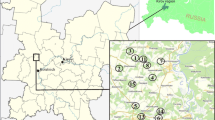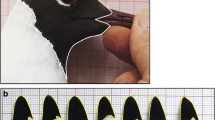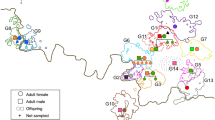Abstract
Colonies of the cosmopolitan urochordate Botryllus schlosseri that share one or both alleles at a single allorecognition locus (Fu/HC) and come into tissue contacts, may fuse and form a mixed entity, a chimera. Botryllus populations worldwide exhibit unprecedented extensive polymorphism at this locus, a result that restricts fusions to kin encounters. This study aims to compare spatiotemporal configurations in source and introduced B. schlosseri populations, residing on natural and man-made substrata, respectively. By using four microsatellite loci, we tested genetic consanguinity of colonies settled naturally along spatial vectors on both, natural (native populations) and man-made (introduced) substrates. Four populations were studied. Results revealed that B. schlosseri colonies, on both substrate types, assemble in groups of relatives that share similar microsatellite profiles. We suggest that this pattern of settlement promotes the formation of chimeras, which evoke conflicting interactions: cooperation between different somatic cell lines that constitute the colonial soma and competition between germ cells that inhabit the chimera gonads. Under natural conditions, the chimera may allow genetic flexibility that depends on joint genomic fitness of its partners. This is probably one of the life history characteristics that led to the worldwide distribution success of this species.

Similar content being viewed by others
References
Ben-Shlomo R, Douek J, Rinkevich B (2001) Heterozygote deficiency and chimerism in remote populations of a colonial ascidian from New Zealand. Mar Ecol Prog Ser 209:109–117
Ben-Shlomo R, Paz G, Rinkevich B (2006) Post glacial period and recent invasions shape population genetics of botryllid ascidians along European Atlantic coasts. Ecosystems 9:1118–1127
Berrill NJ (1950) The Tunicata. Bernard Quaritch Ltd., London
Buss LW (1982) Somatic cell parasitism and the evolution of somatic tissue compatibility. Proc Natl Acad Sci USA 79:5337–5341
Chadwick-Furman NE, Rinkevich B (1994) A complex allorecognition system in a reef-building coral: Delayed responses, reversals and nontransitive hierarchies. Coral Reefs 13:57–63
Chadwick-Furman NE, Weissman IL (1995) Life history plasticity in chimaeras of the colonial ascidian Botryllus schlosseri. Proc R Soc Lond B 262:157–162
Connell JH (1985) The consequences of variation in initial settlement versus post-settlement mortality in rocky intertidal communities. J Exp Mar Biol Ecol 93:11–45
De Tomaso AW, Weissman IL (2004) Evolution of a protochordate allorecognition locus. Science 303:977
Frank SA (2003) Perspective: Repression of competition and the evolution of cooperation. Evolution 57:693–705
Giraud T, Pedersen JS, Keller L (2002) Evolution of supercolonies: The Argentine ants of southern Europe. Proc Natl Acad Sci USA 99:6075–6079
Giraud T, Blatrix R, Poteaux C, Solignac M, Jaisson P (2001) High genetic relatedness among nestmate queens in the polygynous ponerine ant Gnamptogenys striatula in Brazil. Behav Ecol Sociobiol 49:128–134
Grosberg RK (1981) Competitive ability influences habitat choice in marine invertebrates. Nature 290:700–702
Grosberg RK (1987) Limited dispersal and proximity-dependent mating success in the sessile colonial ascidian Botryllus schlosseri. Evolution 41:372–384
Grosberg RK (1988) The evolution of allorecognition specificity in clonal invertebrates. Quarterly Rev Biol 63:377–412
Grosberg RK, Hart MW (2000) Mate selection and the evolution of highly polymorphic self/nonself recognition genes. Science 289:2111–2114
Grosberg RK, Quinn JF (1986) The genetic control and consequences of kin recognition by the larvae of a colonial marine invertebrate. Nature 322:456–459
Grosberg RK, Quinn JF (1989) The evolution of aggression based on allorecognition specificity. Evolution 43:504–515
Hart MW, Grosberg RK (1999) Kin interactions in a colonial hydrozoan (Hydractinia symbiolongicarpus): population structure on a mobile landscape. Evolution 53:793–805
Johnson CR, Seinen I (2002) Selection for restraint in competitive ability in spatial competition systems. Proc R Soc Lond B 269:655– 663
Lambert CC, Lambert G (1998) Non-indigenous ascidians in southern California harbors and marinas. Mar Biol 130:675–688
Lynch M (1990) The similarity index and DNA fingerprinting. Mol Biol Evol 7:478–484
Osman RW, Whitlatch RB (1995) The influence of resident adults on larval settlement: experiments with four species of ascideans. J Exp Mar Biol Ecol 190:199–220
Oka K, Watanabe H (1960) Problems of colony specificity in compound ascidian. Bull Mar Biol Stat Asamushi 10:153–155
Pancer Z, Gershon H, Rinkevich B (1995) Coexistence and possible parasitism of somatic and germ cell lines in chimeras of the colonial urochordate Botryllus schlosseri. Biol Bull 189:106–112
Paz G, Douek J, Mo C, Goren M, Rinkevich B (2003) Genetic structure of Botryllus schlosseri (Tunicata) populations from the Mediterranean coast of Israel. Mar Ecol Prog Ser 250:153–162
Pedersen JS, Krieger MJB, Vogel V, Giraud T, Keller L (2006) Native Supercolonies of Unrelated Individuals In The Invasive Argentine Ant. Evolution 60: 782–791
Pineda J, Caswell H (1997) Dependence of settlement rate on suitable substrate area. Mar Biol 129:541–548
Raymond ML, Rousset F (1995) An exact test for population differentiation. Evolution 49: 1280–1283
Rinkevich B (2002) The colonial urochordate Botryllus schlosseri: from stem cells and natural tissue transplantation to issues in evolutionary ecology. BioEssays 24:730–740
Rinkevich B (2004) Will two walk together, except they have agreed? J Evol Biol 17:1178–1179
Rinkevich B, Shapira M (1999) Multi-partner urochordate chimeras outperform two-partner chimerical entities. Oikos 87:315–320
Rinkevich B, Weissman IL (1987) The fate of Botryllus (Ascidiacea) larvae cosettled with parental colonies: beneficial or deleterious consequences? Biol Bull 173:474–488
Rinkevich B, Yankelevich I (2004) Environmental split between germ cell parasitism and somatic cell synergism in chimeras of a colonial urochordate. J Exp Biol 207:3531–3536
Rinkevich B, Porat R, Goren M (1995) Allorecognition elements on a urochordate histocompatibility locus indicate unprecedent extensive polymorphism. Proc R Soc Lond B 259:319–324
Sabbadin A (1962) La basi genetische della capacita di fusione fra colonie in Botryllus schlosseri (Ascidiacea). Atti Accad Naz Lincei Rc 32:1031–1035
Scofield VL, Schlumpberger JM, West LA, Weissman IL (1982) Protochordate allorecognition is controlled by a MHC-like gene system. Nature 295:499–502
Sommerfeldt AD, Bishop JDD, Wood CA (2003) Chimerism following fusion in a clonal ascidian (Urochordata). Biol J Linn Soc 79:183–192
Stoner DS, Weissman IL (1996) Somatic and germ cell parasitism in a colonial ascidian: possible role for a highly polymorphic allorecognition system. Proc Natl Acad Sci USA 93:15254–15259
Stoner DS, Rinkevich B, Weissman IL (1999) Heritable germ and somatic cell lineage competitions in chimeric colonial protochordates. Proc Natl Acad Sci USA 96:9148–9153
Stoner DS, Ben-Shlomo R, Rinkevich B, Weisman IL (2002) Genetic Variability of Botryllus schlosseri invasions to the East and West Coasts of USA. Mar Ecol Prog Ser 243:93–100
Strassmann JE, Colin RH, Queller DC, Turillazzi S, Cervo R, Davis SK, Goodnight KF (1989) Genetic relatedness in primitively eusocial wasps. Nature 342:268–269
Thorne BL (1982) Multiple primary queens in termites: phyletic distribution, ecological context, and a comparison to polygyny in Hymenoptera. In: Breed MD, Michener CD, Evans HE (eds) The Biology of social insects. Westview Press, Boulder, Colorado, pp 206–211
Tschinkel WR (1993) Resource allocation, brood reduction and cannibalism during colony founding in the fire ant, Solenopsis invicta. Behav Ecol Sociobiol 33:209–233
Tsutsui ND, Suarez AV, Grosberg RK (2003) Genetic diversity, asymmetrical aggression, and recognition in a widespread invasive species. Proc Natl Acad Sci USA 100:1078–1083
Tsutsui ND, Suarez AV, Holway DA, Case TJ (2000) Reduced genetic variation and the success of an invasive species. Proc Natl Acad Sci USA 97:5948–5953
Van Name WG (1945) The North and South American ascidians. Bull Am Museum Nat Hist 84:220–222
Weissman IL, Saito Y, Rinkevich B (1990) Allorecognition histocompatibility in a protochordate species: Is the relationship to MHC semantic or structural? Immunol Rev 113:227–241
Yund PO, O’Neil PG (2000) Microgeographic genetic differentiation in a colonial ascidian (Botryllus schlosseri) population. Mar Biol 137:583–588
Acknowledgements
We would like to express our thanks to the anonymous referees, whose helpful suggestions contributed significantly to this study. The work was supported by grants from the EC Marine Genomics Network of Excellence, Israel Science Foundation (550/06) and from the US-Israel Bi-National Foundation (2003–010).
Author information
Authors and Affiliations
Corresponding author
Rights and permissions
About this article
Cite this article
Ben-Shlomo, R., Motro, U., Paz, G. et al. Pattern of settlement and natural chimerism in the colonial urochordate Botryllus schlosseri . Genetica 132, 51–58 (2008). https://doi.org/10.1007/s10709-007-9148-3
Received:
Accepted:
Published:
Issue Date:
DOI: https://doi.org/10.1007/s10709-007-9148-3




